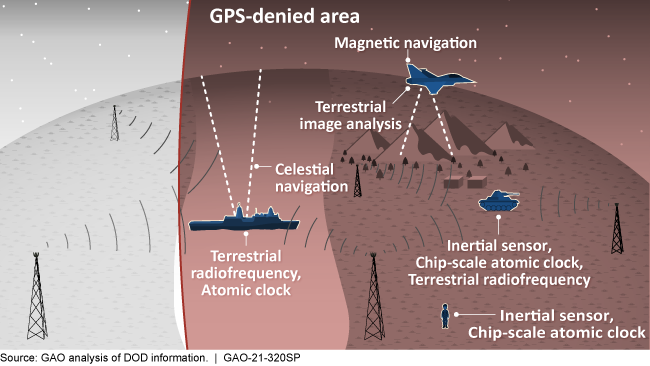Defense Navigation Capabilities: DOD is Developing Positioning, Navigation, and Timing Technologies to Complement GPS
Fast Facts
DOD uses satellite-based GPS for critical operations with its aircraft, ships, munitions, land vehicles, and ground troops. DOD is developing positioning, navigation, and timing technology to complement GPS or as an alternative when GPS is unavailable.
We looked at challenges DOD faces in developing and fielding these new technologies, and identified policy options to help address them.
For example, the level of precision that GPS provides may not be needed for all applications. Clarifying the performance requirements for new technologies—instead of defaulting to GPS-level precision—could help get appropriate technology into the field faster.
Technologies that could be used in an environment where GPS is unavailable

Highlights
What GAO Found
The Department of Defense (DOD) plans to keep the Global Positioning System (GPS) at the core of its positioning, navigation, and timing (PNT) solution, using other PNT technology to complement GPS or as an alternative for when GPS is degraded or unavailable. DOD’s alternative PNT science and technology portfolio explores two approaches: improved sensors to provide relative PNT information, and external sources to provide absolute positioning and navigation. Relative PNT technologies include inertial sensors and clocks to allow a platform to track its position and keep track of time without an external signal like GPS. However, relative PNT technologies require another PNT technology to correct errors that can accumulate with such systems. Absolute PNT technologies allow a platform to use external sources of information to determine its position but rely on the availability of those external sources. Absolute PNT technologies include celestial and magnetic navigation as well as the use of very low radiofrequencies or low Earth orbit satellites to transmit information.
Technologies that could be used in GPS-denied environment

DOD may use multiple PNT technologies to provide sufficient PNT information to its various military platforms. DOD is pursuing approaches, such as creating common standards and interfaces, to aid in integrating and fielding new PNT technologies faster and at lower cost. DOD is developing its PNT modeling and simulation capabilities to evaluate the performance of new PNT technologies.
DOD faces challenges in developing and integrating alternative PNT technologies. Officials from across DOD and experts told GAO that alternative PNT solutions are not prioritized within DOD. For example, there is no central program office responsible for developing the variety of alternative PNT technologies across DOD. DOD’s continued reliance on GPS, despite known GPS vulnerabilities to disruption, presents a challenge for obtaining sufficient support to develop viable alternatives. DOD officials and experts also said challenges in establishing clear PNT performance requirements hinder technology development.
GAO developed six policy options that may help address challenges with developing and integrating alternative PNT technologies. The policy options identify possible new actions by policymakers, who may include Congress, federal agencies, and industry groups. See below for details of the policy options and relevant opportunities and considerations.
Policy options that may help address challenges with developing and integrating alternative PNT technologies
| Opportunities | Considerations | |
|
Increase Collaboration Policymakers could consider mechanisms to coordinate across DOD to clarify responsibilities and authorities in prioritizing the need for alternative PNT technologies. |
|
|
|
Focus on Resiliency Policymakers could consider selecting the most resilient technologies as the cornerstone of the PNT suite for military missions, rather than defaulting to GPS. |
|
|
|
Clarify Requirements Policymakers could consider opportunities for DOD to clarify what level of PNT performance is actually needed for missions, rather than defaulting to requirements that match GPS performance. |
|
|
|
Coordinate with Industry Policymakers could consider ensuring that DOD and commercial industry coordinate so industry is prepared to meet DOD’s needs, and DOD can leverage industry advances. |
|
|
|
Institutionalize Open Architecture Policymakers could consider making the open architecture initiative more permanent, including providing funding. |
|
|
|
Analyze Vulnerabilities Policymakers could consider having DOD conduct ongoing analysis of vulnerabilities of different PNT systems.
|
|
|
Source: GAO. | GAO-21-320SP
Why GAO Did This Study
For decades, the satellite-based GPS has transmitted PNT data to receivers used by military platforms and personnel worldwide. PNT information is essential in many facets of DOD operations. Given the ubiquity of GPS, the failure, malfunction, or jamming of its signals or equipment could disrupt military activities involving aircraft, ships, munitions, land vehicles, and ground troops. This possibility has led DOD to explore alternatives to GPS.
GAO was asked to assess the alternative PNT technologies DOD is developing. This report discusses (1) how DOD plans to meet future PNT needs and the capabilities and limitations of alternative PNT technologies, (2) how alternative PNT technologies integrate with one another and with current PNT capabilities, and (3) policy options that may help address challenges with the development and integration of alternative PNT technologies.
To address these objectives, GAO reviewed technical studies, agency documents, and other key reports; interviewed government officials and researchers about alternative PNT technologies; and convened a 3-day meeting of experts from government, non-governmental organizations, academia, and industry. GAO is identifying policy options in this report.
For more information, contact Karen L. Howard at (202) 512-6888 or HowardK@gao.gov or Jon Ludwigson at (202) 512-4841 or LudwigsonJ@gao.gov.
